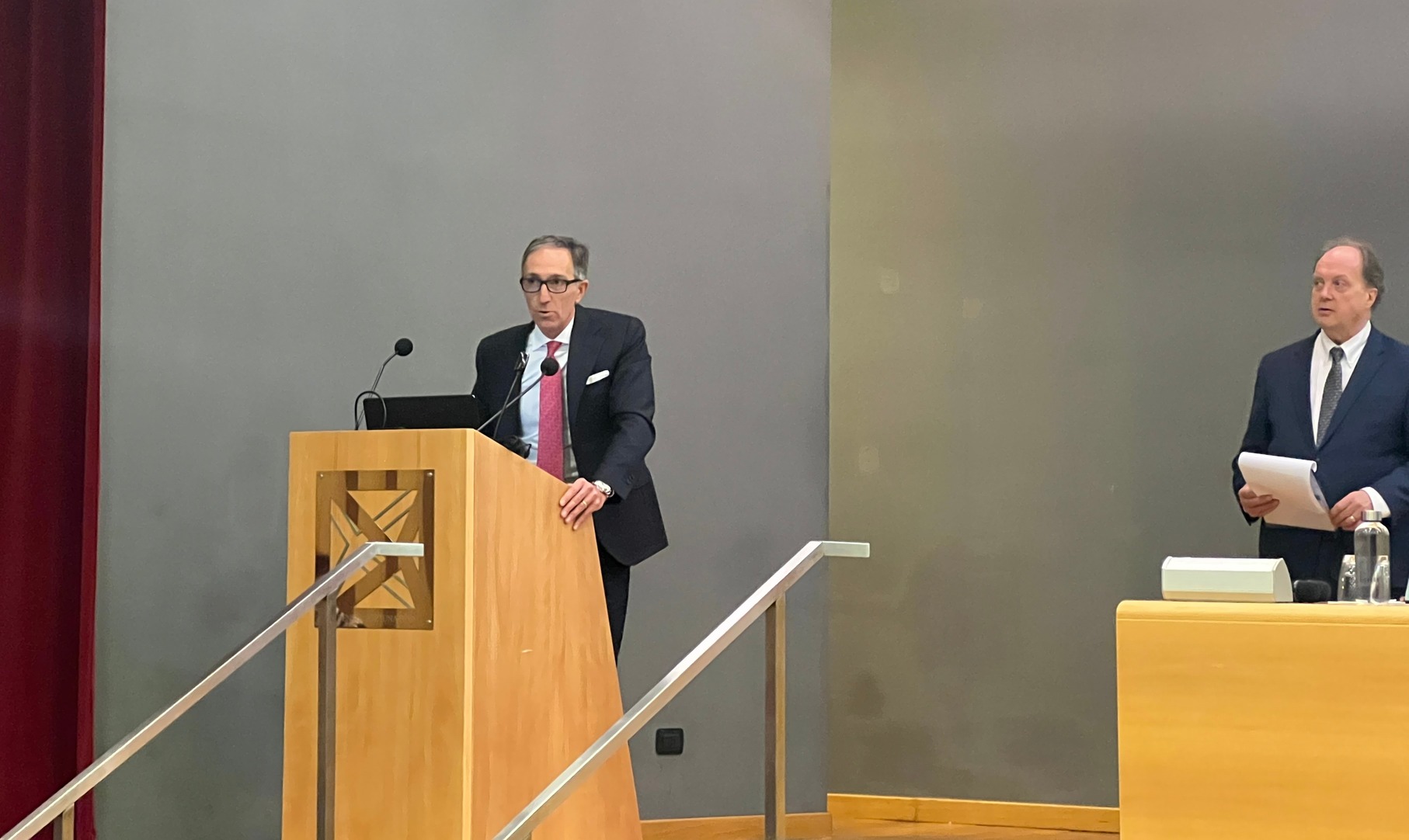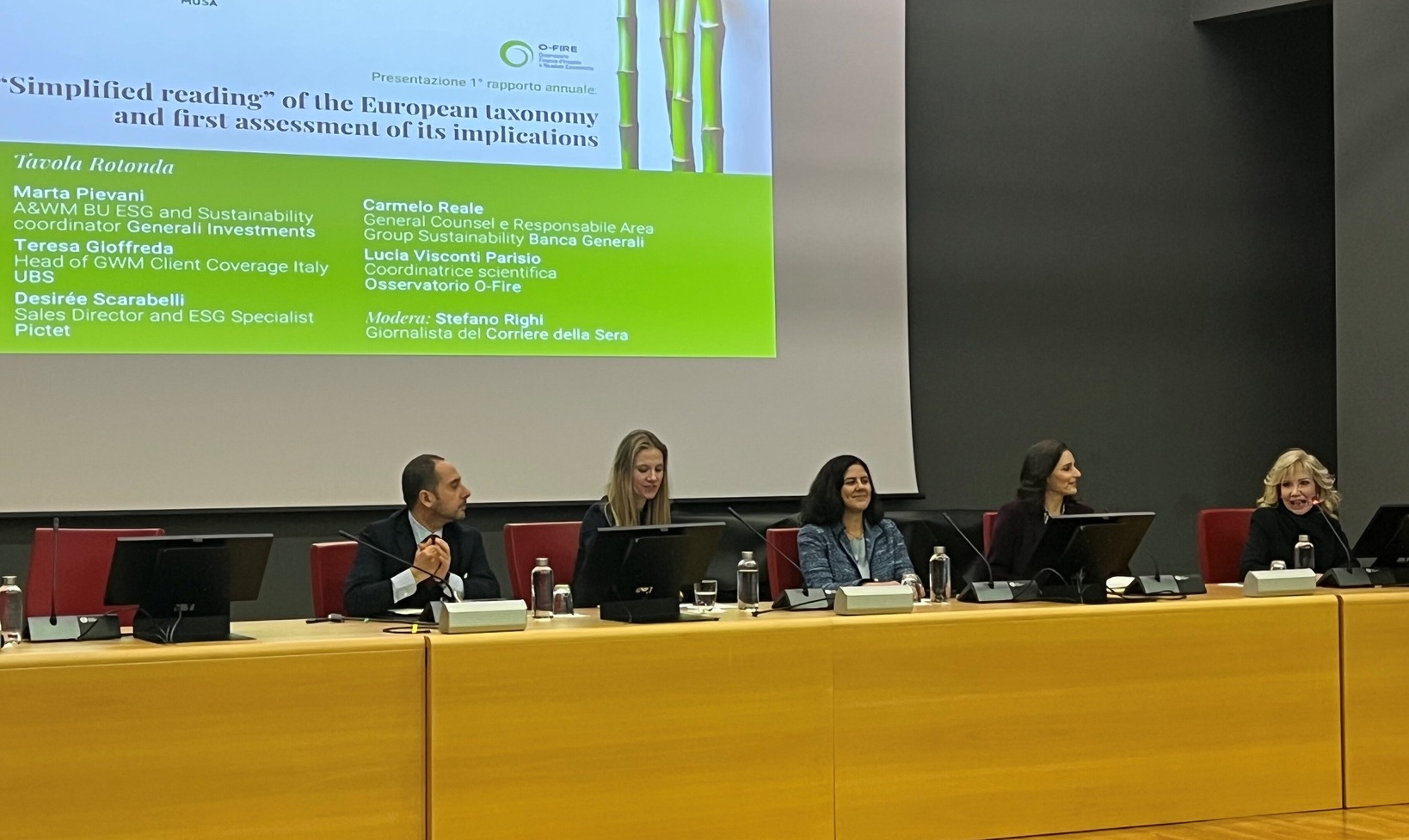
O-Fire: Banca Generali and the University of Milano-Bicocca for green taxonomy
Presented today at the "Guido Martinotti" Auditorium in Milan the first annual report of the Observatory on Sustainable Finance promoted by Banca Generali, AIFI and the University of Milan Bicocca
When can a business activity be called sustainable? It is to answer this question that in recent years what is called the European Taxonomy of Sustainable Investments was born in the financial and international business community, i.e., a set of rules and criteria that in the Old Continent have a twofold purpose: both to direct capital flows toward activities that promote the energy transition and to prevent greenwashing, i.e., that deceptive practice by which certain activities are passed off as environmentally sustainable when in fact they are not. The Taxonomy therefore affects those who manage savings such as asset managers but also all other players in the financial industry, for example banks but also financial advisers.
All these topics were the focus of the First Annual Report of O-Fire (Observatory on Impact Finance and its Economic Implications), the Observatory on Sustainable Finance launched a year ago by the University of Milano-Bicocca together with Banca Generali, asset management partners (Generali Investments, Pictet, Ubs) and Aifi (Italian Association of Private Equity, Venture Capital and Private Debt) . Titled ""Simplified reading" of the European taxonomy and first assessment of its implications," the Report was presented Tuesday, Nov. 29, at the "Guido Martinotti" Auditorium of the University of Milan-Bicocca.
"Sustainability is one of the fundamental themes of our university's strategic plan," said University of Milano-Bicocca" rector Giovanna Iannantuoni, "and for this reason a year ago we wanted to give birth to the O-Fire Observatory, which, thanks to the collaboration between the University of Milano-Bicocca, Banca Generali and Aifi, is proposed as a scientific body of reference for green finance in Italy."
"Great responsibility and coordination is needed on the part of institutions to channel the efforts of companies in the sustainable transition in the right direction," said Andrea Ragaini, deputy general manager of Banca Generali, who added, "After an initial phase of strong growth in environmental awareness and ESG investment offerings from asset managers that have variously involved economic and production activities, there is now a need to focus on defining best practices and direct this virtuous path even more constructively."

The Observatory's first report and ESG taxonomy
The First O-Fire Observatory Report was conducted on a sample of large European companies (1,391 with combined revenues of $10 trillion) and reveals that there is still a long way to go in Europe to have a universally recognized framework of rules and criteria. The companies were examined by taking more than 800 ESG (environmental, social and governance) variables as reference, of which 370 were related to the environment (e.g., emissions, carbon footprint, renewables, energy efficiency, water consumption, biodiversity and land use).
What the researchers found was a mismatch between these variables and those contained in the Taxonomy criteria, i.e., those criteria that precisely identify sustainable activities, thus capable of making a substantial contribution to climate change mitigation and adaptation. "These are not the same parameters," the O-Fire researchers point out, "or they are the same, but the degree of detail is not comparable to that required by the Taxonomy."

ESG taxonomy: the role of asset management
All these issues certainly cannot leave asset management companies indifferent. It was no coincidence that three representatives of leading asset management companies were also present at the O-Fire Observatory presentation: Desirée Scarabelli, sales director and ESG Specialist at Pictet; Marta Pievani, coordinator of the ESG and Sustainability Business Unit at Generali Investments A&WM; and Teresa Gioffreda, head of GWM Client Coverage Italy at Ubs.
"Generali Investments is an ecosystem of multiple asset management companies," Pievani said, "bringing together diverse expertise and an equally diverse approach to sustainable investing." Pievani cites Sycomore AM, a pioneer in sustainable investing that has been instrumental in establishing ESG criteria in the European market over the past 20 years.
"Our first product on the sustainability front was born a full 25 years ago, in 1997," said Gioffreda of Ubs, who added, "at first we were mainly palming off exclusionary criteria, often lumped in with ethical or religious values, limiting this preference to a niche market. In the ten years since, the industry has moved toward the active use of ESG (environmental social and governance) criteria, in stock selection processes, beginning to appreciate their added value, especially in terms of risk reduction."
Gioffreda then pointed out how there has been a growing awareness among financial institutions over time "to join forces and be part of organizations that are actively working to achieve net zero emissions by 2050. "We do engagement with companies," Gioffreda added, "that is, we enter into dialogue with them trying to get them to improve in social environmental and governance factors. And we do that both on our own and collectively with other large investors to increase our impact on the goals we care about."
Also important was the testimony of Desirée Scarabelli of Pictet, a pioneer in sustainable investing, a field in which she has "tried her hand" since the 1990s. "More than twenty years ago, when throughout the financial industry there was mostly talk of investing in technology and technology companies," says Sacarabelli, "we launched the first thematic environmental fund, Pictet Water, linked to the theme of water resources."
Pictet initially encountered some skepticism in the financial community, but the facts have shown how that choice was forward-looking. "Since the launch of that fund and other products, a big thread has started," says Scarabelli, who recalls the evolution Esg investments have undergone over time. Before, management houses were focused on identifying good themes to invest in.
Then, asset management companies became increasingly aware of their active role, that is, the possibility of working themselves to push companies to implement increasingly virtuous behavior on the sustainability front. In addition, Pictet also realized the importance of having external partners to help it identify the most relevant megatrends on the Esg investment front in good time.
On the other hand, the analysis in the Report showed greater resilience of sustainable investments compared to the market and some correlation between environmental and financial performance of companies, particularly energy companies.
From its analysis of various sources (Morningstar, Bloomberg, and OECD), the Observatory found that sustainable funds had net inflows of $23 billion in the third quarter of 2022, compared with $35 billion in the previous quarter and about $80 billion in the first quarter; conventional investments (generalized market funds), on the other hand, experienced outflows of about $280 billion in the second quarter and $200 billion in the third quarter. Sustainable funds were thus more resilient to the current economic crisis.
/original/BG4SDGS+Talks+%281%29.png)

